Biologists knew that, of course, the neatly linear line from critter to modern man does not exist, it happened in fits and starts and sometimes different ways numerous times. But as the study of evolution becomes more multi-discplinary our chances of finding new fossils increases, and ideas of what ancestors looked like go from theoretical to real.
A team of researchers has announced the discovery of a partial foot skeleton with characteristics - such as an opposable big toe bone - that don't match those of Lucy, the human ancestor (hominin) known to inhabit that region and considered by many to be the ancestor of all modern humans. The discovery provides evidence that at least two pre-human ancestors lived between 3 million and 4 million years ago in the Afar region of Ethiopia and that they had different ways of moving around the landscape.
The paper describes the foot, similar in some ways to the remains of another hominin fossil, Ardipithecus ramidus, but which has different features. You can see it here:

Burtele hominin partial foot in the lab after cleaning; It is shown here in its anatomically articulated form. Credit: The Cleveland Museum of Natural History. Courtesy: Yohannes Haile-Selassie
"The foot belonged to a hominin species -- not yet named -- that overlaps in age with Lucy (Australopithecus afarensis). Although it was found in a neighboring project area that is relatively close to the Lucy fossil site, it does not look like an A. afarensis foot," explains geologist Naomi Levin, an assistant professor in the Morton K. Blaustein Department of Earth and Planetary Sciences at Johns Hopkins University. "What is clear is that the foot of the Burtele hominin was able to grasp items much better than its contemporary, A. afarensis, would have been able to do, which suggests that it was adept at moving around in trees."
It shows that there is much more to learn about the role of locomotion in human evolution.
"This fossil makes the story of locomotion more complex, and it shows that we have a lot more to learn about how humans transitioned from moving around in trees to moving around on the ground -- on two legs.This fossil shows that some hominins may have been capable of doing both," she says.
The fossil, dated to approximately 3.4 million years ago, was discovered in 2009 in sediments along the Burtele drainage in the Afar region of Ethiopia that is now very hot and dry. The researchers believe the area was wetter and more wooded when the Burtele hominin lived, based on its deltaic sedimentary context, results from isotopic studies and the range of fossil animals found near the site.
"We're just at the beginning of understanding the environmental context for this important fossil. It will be a critical part of understanding this hominin, its habitat and the role that the environment played in its evolution," Levin says.





Comments